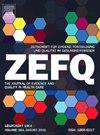Dermatologische Diagnostik bei Patient*innen mit „skin of color“ – Wie sicher fühlen sich deutsche Dermatolog*innen?
IF 1.7
Q4 HEALTH POLICY & SERVICES
Zeitschrift fur Evidenz Fortbildung und Qualitaet im Gesundheitswesen
Pub Date : 2025-02-01
DOI:10.1016/j.zefq.2024.11.011
引用次数: 0
Abstract
Introduction
Diagnosis in dermatology is primarily based on the assessment and description of the clinical appearance of the skin. The German medical literature focuses almost exclusively on white skin, so it is questionable whether this one-sided training is sufficient to do justice to all patients since the diversity of skin types increases.
Methods
Online survey among German dermatologists regarding training and experience in the diagnosis of dark skin, difficulties in recognizing dermatoses and the desire for training and further education in skin diseases of “skin of color”.
Results
A total of 236 responses were received. 65 % of participants felt unsure to very unsure about recognizing skin conditions in people with dark skin. Training in the recognition of skin types IV–VI was rated as poor to very poor by 76 %, and 73 % rated the current literature on the diagnosis of dark skin as poor to very poor. 89 % reported that they have difficulties in diagnosing skin diseases in dark skin in their daily practice.
Conclusion
There is uncertainty among German dermatologists in the diagnosis of skin diseases in people with dark skin. This diagnostic uncertainty may lead to poorer treatment outcomes. More training opportunities should be offered to improve skills in the diagnosis and treatment of skin diseases in skin of color and the associated care.
“有色皮肤”患者的皮肤科诊断——德国皮肤科医生有多自信?]
简介:皮肤科的诊断主要是基于对皮肤临床表现的评估和描述。德国医学文献几乎只关注白色皮肤,因此,由于皮肤类型的多样性增加,这种片面的训练是否足以公平对待所有患者,这是值得怀疑的。方法:对德国皮肤科医生进行在线调查,了解他们在深色皮肤诊断方面的培训和经验、识别皮肤病的困难以及对“有色皮肤”皮肤病培训和继续教育的愿望。结果:共收到236份回复。65%的参与者对识别深色皮肤的人的皮肤状况感到不确定或非常不确定。76%的人将识别皮肤类型IV-VI的培训评为差到非常差,73%的人将目前关于黑皮肤诊断的文献评为差到非常差。89%的人报告说,他们在日常实践中难以诊断深色皮肤的皮肤病。结论:德国皮肤科医生对深色皮肤人群皮肤病的诊断存在不确定性。这种诊断的不确定性可能导致较差的治疗结果。应提供更多的培训机会,以提高有色人种皮肤病的诊断和治疗技能以及相关护理。
本文章由计算机程序翻译,如有差异,请以英文原文为准。
求助全文
约1分钟内获得全文
求助全文
来源期刊

Zeitschrift fur Evidenz Fortbildung und Qualitaet im Gesundheitswesen
HEALTH POLICY & SERVICES-
CiteScore
1.90
自引率
18.20%
发文量
129
 求助内容:
求助内容: 应助结果提醒方式:
应助结果提醒方式:


